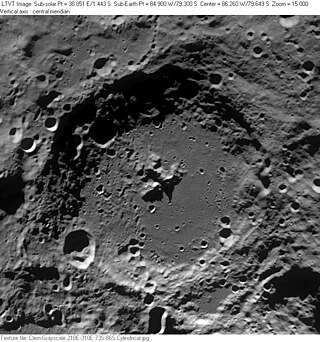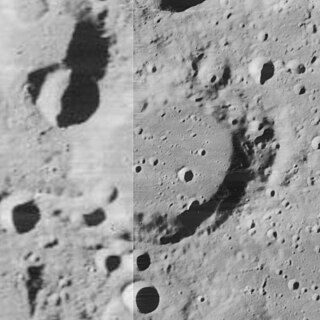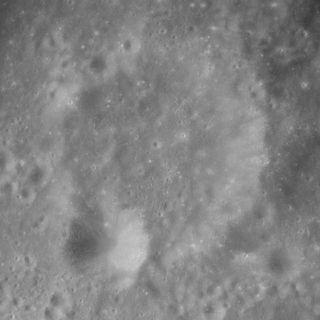
Ansgarius is a lunar impact crater that is located near the eastern limb of the Moon. When viewed from the Earth, the crater has a highly oval shape due to foreshortening, but the rim is actually nearly circular. To the northwest of Ansgarius is the crater La Pérouse, and south is Behaim.

Appleton is a heavily eroded lunar impact crater that lies in the northern hemisphere on the far side of the Moon. To the northwest are the craters Von Neumann and Campbel. The smaller Golovin lies to the northeast, while further to the southwest is the Mare Moscoviense.

Ashbrook is a large lunar impact crater that is located in the vicinity of the south pole on the far side of the Moon, and so cannot be viewed directly from the Earth. The eastern face of the crater has been overlain by the similar-sized Drygalski, and more than half the interior floor of Ashbrook is covered by the outer ramparts and ejecta of Drygalski. To the northwest is the walled plain Zeeman.

Barrow is an old lunar impact crater that is located near the northern limb of the Moon. It lies between the crater Goldschmidt to the northwest and the irregular formation Meton to the northeast. To the southwest is W. Bond.

Byrd is an irregular lunar impact crater that is located near the north pole of the Moon. The north rim of Byrd is nearly connected to the crater Peary, a formation that is adjacent to the pole. The smaller crater Gioja is attached to the remains of the southwest rim.

Boyle is a lunar impact crater that is located in the southern hemisphere on the rugged far side of the Moon. It is adjacent to the larger crater Hess to the southeast, and lies about midway between the craters Alder to the north-northeast and Abbe to the south-southwest.

Boole is a lunar impact crater that lies along the northwestern limb of the Moon, to the northwest of the crater Gerard. At this location it is viewed nearly from the side, and is very oblong in shape due to foreshortening. The crater formation is nearly circular, however, with a wide inner wall that has been worn and rounded due to subsequent impacts. It is named after George Boole.

Chamberlin is a lunar impact crater that is located on the far side of the Moon, just past the southeastern limb. It lies to the southeast of the crater Jeans, and Moulton is attached to the southeastern rim of Chamberlin. This crater is located in a part of the lunar surface that has undergone resurfacing of crater interiors, producing dark-hued crater floors.

Becquerel is a lunar impact crater that lies in the northern hemisphere on the far side of the Moon. This is an ancient and heavily worn formation that is now little more than an irregular buri in the surface. The outer rim has been worn and reshaped until it forms a rugged, mountainous region around the flatter interior.

Birkhoff is a giant lunar walled plain that is located on the far side of the Moon, in the northern hemisphere. This formation is an ancient impact site that has been heavily eroded, and the surface reshaped by multiple craters in the interior and along the rim. The outer wall is bordered by the craters Carnot to the south, Rowland along the west rim, and Stebbins to the north. Just to the northeast is van't Hoff.

Rost is a lunar impact crater that is located in the southwestern part of the Moon, to the southeast of the elongated formation Schiller. To the southeast of Rost is the larger crater Scheiner. West-southwest of this formation is the smaller Weigel.

Cannon is a lunar impact crater that is located near the east-northeastern limb of the Moon's near side. It lies just to the northwest of the Mare Marginis, and south-southeast of the crater Plutarch. Farther to the east-northeast is Hubble.

De Roy is a lunar impact crater that is located on the far side of the Moon, just behind the southwestern limb. This portion of the lunar surface is brought into view during favorable librations, allowing observation of this formation. However the crater is viewed from the side when watched from the Earth, and little detail can be seen. De Roy lies to the west of the crater Arrhenius, and east of the larger Boltzmann.

Drygalski is a large lunar impact crater that lies along the southern limb of the Moon. It partly overlies the crater Ashbrook to the west on the far side of the Moon. Just to the north of Drygalski is the smaller Boltzmann. The location of this crater restricts its observation from the Earth, and even under conditions of favorable libration it is viewed from the edge. It is only illuminated by the Sun at an oblique angle, and it lies close to the south polar craters that are permanently shielded from sunlight.

Le Gentil is a lunar impact crater that is located in the south-southwest part of the Moon, near the limb, and is nearly attached to the southern rim of the huge walled plain Bailly. To the southeast is the large crater Drygalski. Due to its location, this crater appears considerably foreshortened and is viewed from an oblique angle by observers on the Earth.

Cleostratus is a lunar impact crater near the northwest limb of the Moon. It lies to the northeast of the crater Xenophanes, and west-southwest of the prominent Pythagoras. From the Earth this crater appears highly elongated due to foreshortening.

Challis is a lunar impact crater that is located in the northern regions of the Moon's near side, close enough to the limb to appear significantly foreshortened when viewed from the Earth. It is joined to the crater Main through a break in the northern rim, and is close to Scoresby along the southeast side.

Dyson is a lunar impact crater, 63 kilometers in diameter, that lies on the far side of the Moon, past the northwest limb. It is located in the northern part of the surface, to the northwest of the crater Coulomb, and east of van't Hoff.

Dale is a small lunar impact crater located in the far eastern part of the Moon's near side, to the south of the Mare Smythii. It lies to the southeast of the larger crater Kastner and northeast of Ansgarius. The crater is located in a part of the lunar surface that is subject to libration, which can hide it from view for periods of time.

Hippocrates is a lunar impact crater on the far side of the Moon. It is located in the northern region of the lunar surface, to the north of the crater Stebbins. To the southwest of Hippocrates are Kirkwood and the large Sommerfeld.






















